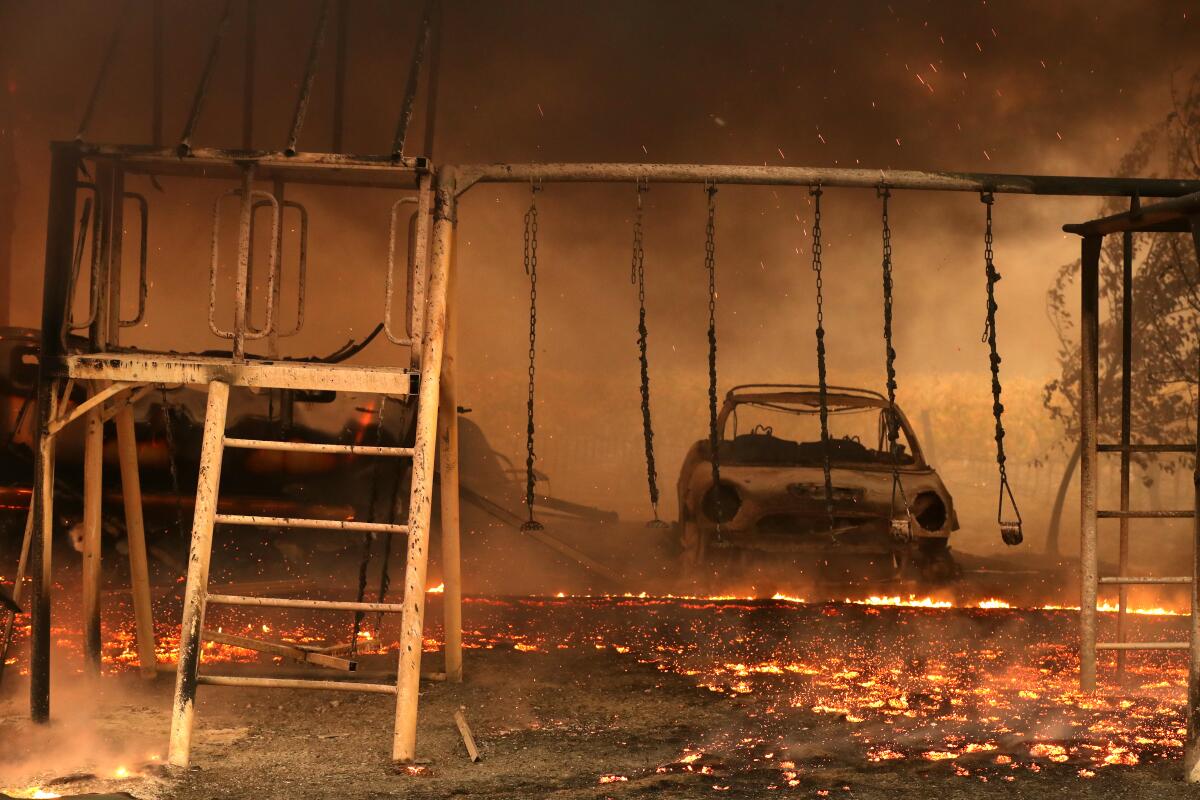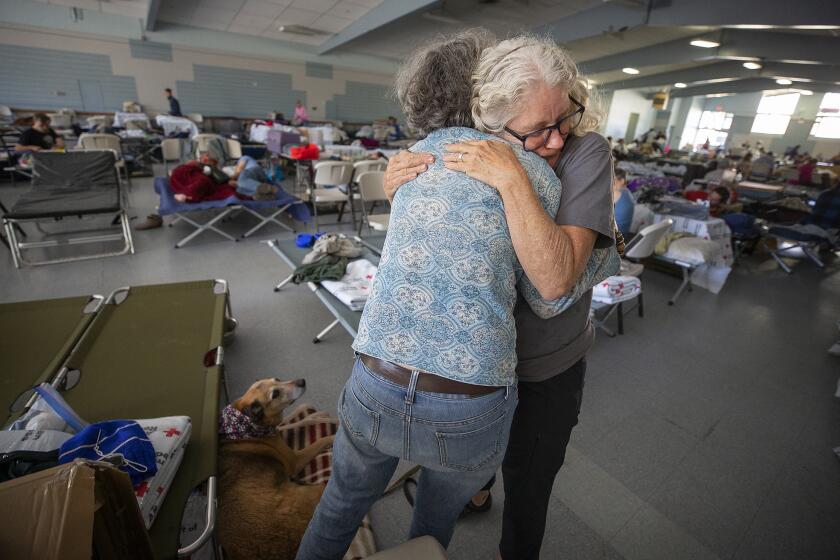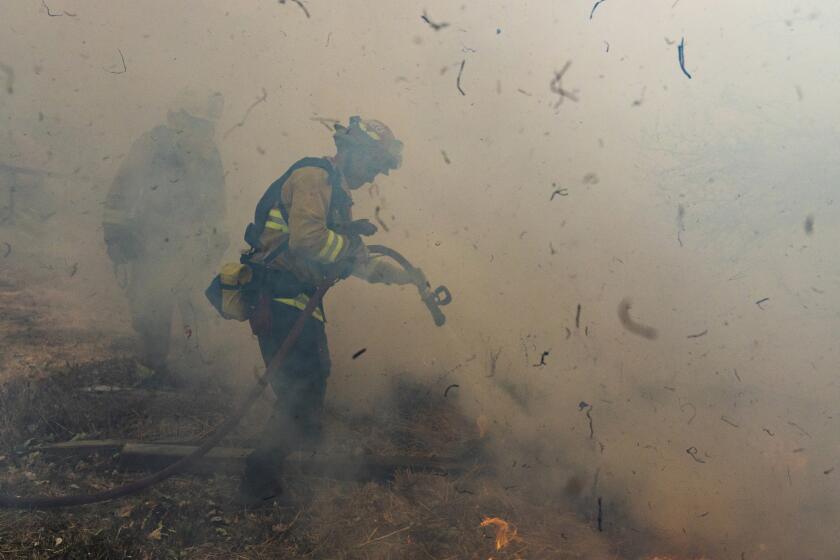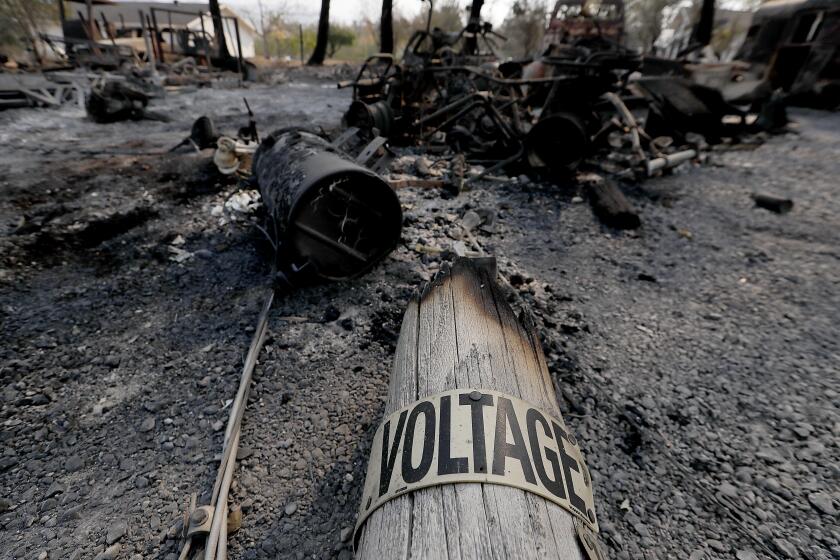Kincade fire: Evacuees return, PG&E begins power restoration as firefighters make progress

CALISTOGA, Calif. — Following three major bouts of winds that hindered firefighters’ efforts battling the massive Kincade fire and prompted “public safety power shut-offs” to millions, Pacific Gas & Electric Co. started restoring power to most areas and officials began allowing nearly all of the 190,000 evacuated residents to return home.
Crews on Wednesday began to inspect utility lines, repair damage and restore power to about 365,000 customers in its service area, except for Kern County, which was still experiencing strong winds, according to PG&E. Inspections were expected to begin Thursday morning in Kern County, the utility said.
The mandatory evacuation zones that encompassed the towns of Windsor and Healdsburg were downgraded to an evacuation warning, meaning that although the area is still at risk, residents could come back, according to Sonoma County sheriff’s officials.
The Santa Rosa Police Department announced just after 12 p.m. that city residents could safely return.
Some 800 firefighters battled the wind-whipped Easy fire surrounding the Ronald Reagan Presidential Library. They were stymied by intense gusts that sent embers flying far beyond the body of the blaze.
The news came after harsh winds and fire weather in Northern California calmed, helping firefighters entering their seventh day battling the flames.
Containment of the fire, which grew slightly to 76,825 acres, doubled to 30% as of Wednesday morning, according to the California Department of Forestry and Fire Protection.
“The eastern part of the fire was active overnight, but firefighters continued to make forward progress as a whole,” even amid the final strong wind event of the week, according to fire and weather officials.
Tuesday night, winds in high terrain reached 60 mph, and in the valleys where the fire is burning, winds blew up to 30 mph, said Spencer Tangen, a meteorologist with the National Weather Service. By Wednesday morning, the winds had begun to slow.
The Times is offering fire coverage for free today. Please consider a subscription to support our journalism.
“We’re not expecting another wind event similar to what we’ve seen, at least until mid next week,” Tangen said. That will probably help firefighters continue to make progress.
Jonathan Cox, a Cal Fire spokesman, said Tuesday that firefighters were bracing for a challenging evening.
A quarter of the evacuation centers in Sonoma, Marin, Alameda and Napa counties were at capacity. Evacuees had a shrinking list of alternatives.
“If we are looking good as far as fire growth this time tomorrow morning, I feel like that cautious optimism will be solidified,” he said. “If we’re not, if we have explosive growth tonight, we have our work cut out for us.”
The outcome was in their favor: Gusts in the valleys near where the Kincade fire was burning were not as strong, and the wind event was weaker overall than previous ones, Tangen said.
Despite the fire’s massive scale and the large number of structures that have burned — 94 homes have been destroyed — no deaths have been reported in the blaze. Fire officials say that’s partly due to a proactive approach and vast evacuation zones that have taken many out of harm’s way.
Because the heavy winds were widely anticipated and the fire started in a less-populated area, crews had much more time than they did during the 2017 Tubbs fire to evacuate people and get prepared, even with the looming blackouts, authorities said. Strike teams were already in the area around the Kincade fire before it broke out, allowing for a swift response.
Cox said fire crews, in anticipation of the coming blackouts, tried to get people evacuated before the power went out.
“Firefighters are very good at operating without power,” he said. “A lot of times, we ask for it to be closed down on fires to minimize the risk. ... I think, for us, it kind of reinforces the message that early evacuation is so important because of the potential that you may not have power later down the line.”
Winds in Northern California are expected to peak again Tuesday evening. With gusts reaching 60 mph, PG&E says more shut-offs are possible.
Even as PG&E has shut off power to prevent additional fires, Northern California continues to see small fires. The utility revealed Monday that its equipment malfunctioned near two fires that broke out in Contra Costa County on Sunday afternoon, and the California Public Utilities Commission announced it would investigate how PG&E handles its shut-offs.
PG&E notified 540,000 customers their power could be shut off Tuesday and Wednesday. Thanks to favorable weather, the utility did not end up shutting off power to Humboldt and Siskiyou counties. PG&E is still monitoring weather conditions in Alameda, Contra Costa, Santa Clara, Santa Cruz and San Mateo counties.
But for thousands more whose power has been shut off, the last several days have been challenging.
Heidi Santos lost power at her home over the weekend.
The mother of two was camped out at a resource tent outside a Catholic church in St. Helena on Tuesday morning while her 8- and 10-year-old children played at a nearby Boys and Girls Club. As it happened, the tent where she charged her cellphone was provided by PG&E.
Without electricity, Santos couldn’t cook for her young son, who is allergic to a long list of foods — soy, eggs, gluten, almonds and fish.
Even as howling winds calmed Monday, allowing firefighters to chip away at a massive fire in Sonoma County wine country, residents who fled their homes braced for more fear and uncertainty, while millions of others faced prolonged power outages.
What was in her refrigerator had long since spoiled, and Santos’ only option now was buying food from restaurants or nonperishable items from the market. To make matters worse, she hadn’t worked in two days because the home where she worked as a housekeeper had been evacuated.
In Calistoga, a family that lost four homes on its compound to the 2017 Tubbs fire, and was under a mandatory evacuation again, was packing up Tuesday afternoon. But not all were leaving.
Denise Drawski, who lives on the family compound, said she thought the power had gone off Saturday — or maybe it was Sunday. She couldn’t remember exactly.
“We’ve gone without power three out of seven days every week for the last few weeks, so I kind of lose track,” Drawski said.
The temperature was also dipping, and they didn’t have heat. They were running their “little baby generator” every three hours or so, just to keep the refrigerator going and communications open so they could track the fire.
Despite the mandatory evacuation orders, Drawski said, about a dozen neighbors in the area also planned to stay.
“Almost all of us have our own little generators and fire hoses, so we can at least wet down a hundred-foot area,” she said.
Firefighters could only do so much, and this was a lot of acreage for one family, Drawski said. They knew this land, and knew their way through these roads. She had too much skin in the game, she said, to leave just yet.
More to Read
Sign up for Essential California
The most important California stories and recommendations in your inbox every morning.
You may occasionally receive promotional content from the Los Angeles Times.
















